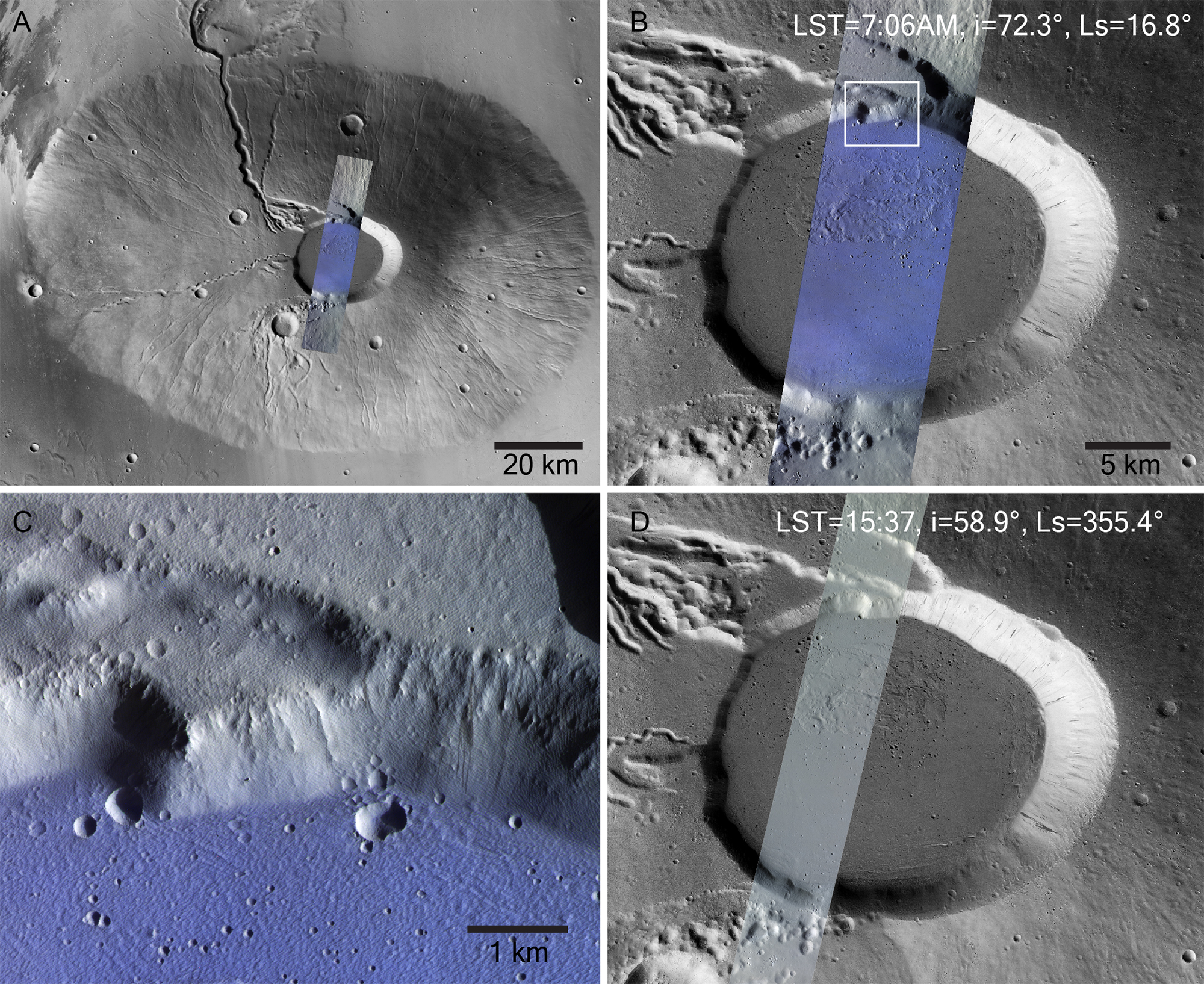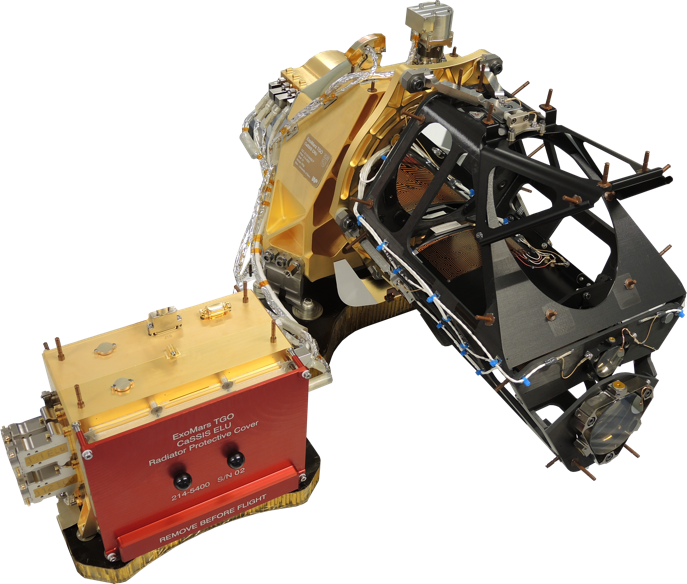First detection of frost on the Solar System’s tallest volcanoes on Mars
For the first time, water frost has been detected on the colossal volcanoes on Mars, which are the largest mountains in the Solar System. The international team led by the University of Bern used high-resolution color images from the Bernese Mars camera, CaSSIS, onboard the European Space Agency’s ExoMars Trace Gas Orbiter spacecraft. Understanding where water can be found, and how it is transported, is relevant for future Mars missions and possible human exploration.
“ExoMars” is a programme of the European Space Agency ESA: for the first time since the 1970s, active research is being conducted into life on Mars. On board the ExoMars Trace Gas Orbiter (TGO) is the Colour and Stereo Surface Imaging System (CaSSIS), a camera system developed and built by an international team led by Professor Nicolas Thomas from the Physics Institute at the University of Bern. CaSSIS has been observing Mars since April 2018 and is delivering high-resolution color images of the surface of Mars.
Using these high-resolution colour images, an international team led by Dr. Adomas Valantinas has been able to detect water frost on Mars. The study has just been published in the Journal Nature Geoscience. Valantinas was a PhD student at the Space Research & Planetary Sciences Department of the Physics Institute of the University of Bern until Ocotober 2023 and is currently a guest researcher at Brown University (USA) thanks to a Swiss National Science Foundation (SNSF) Postdoc.Mobility fellowship.
An unexpected discovery
The frost was detected on the tops of Mars’ tallest mountains – the Tharsis volcanoes. These volcanoes are the tallest mountains in the Solar System, with Olympus Mons towering up to 26 km above the surrounding plains. This frost formation had not been expected because these mountains lie at low latitudes near Mars’ equator. “At these low latitudes, the high amounts of sunshine tend to keep surface temperatures high. Therefore, we did not expect frost to be found there”, as Valantinas says. What is more, the thin atmosphere on Mars is inefficient at cooling the surface, so high altitude surfaces can get as hot as low altitude surfaces at midday, contrary to what happens on Earth.
Valantinas explains: “Upslope winds bring air containing water vapour up from the lowlands, and this aircools as it gets to high altitudes, causing condensation. This is a familiar phenomenon both on Earth and on Mars.” The same phenomenon causes the striking Arsia Mons Elongated Cloud – and the new study shows that it leads to morning frost deposits on the Tharsis volcanoes as well. “As we could see from the CaSSIS images, the thin frosts are only present briefly, for a few hours around sunrise, before they evaporate in the sunlight”, as Valantinas continues.
Successful collaboration
In order to identify the frost, Valantinas and the team analyzed more than 5’000 images made by the Bernese Mars camera CaSSIS. Since April 2018 CaSSIS has provided observations of local dust activity, the seasonal changes in CO2 ice deposits, and the existence of dry avalanches on Mars. As Nicolas Thomas states: “That we now could detect the nighttime deposition of water frost on Mars at visual wavelengths and at high resolution is yet another proof of the impressive scientific capabilities of the Bern camera system.”
The discovery was validated by using independent observations by the High Resolution Stereo Camera (HRSC) onboard the ESA Mars Express orbiter and by the Nadir and Occultation for Mars Discovery (NOMAD) spectrometer onboard TGO. Ernst Hauber, geologist at the DLR Institute of Planetary Research (DLR-Institut für Planetenforschung) in Berlin and co-author of the current study says: “This study nicely demonstrates the value of different orbital assets. Combining measurements from various instruments and modelling, we can improve our understanding of atmosphere-surface interactions in a way that wouldn’t be possible with one instrument alone.” According to Hauber, the results also show how important the long-term monitoring of planetary processes is, as some phenomena only become apparent by comparing multiple measurements over time.
Important findings for future Mars missions
Despite being thin – likely only one-hundredth of a millimetre thick (as thick as a human hair) – the patches of frost cover a vast area. “The amount of frost represents about 150,000 tonnes of water swapping between surface and atmosphere each day during the cold seasons, the equivalent of roughly 60 Olympic swimming pools,” as Valantinas explains.
“Understanding where water can be found, and how it moves between reservoirs, is relevant for many aspects of Mars exploration”, as Nicolas Thomas says. “Of course, we want to understand the physical processes involved in the climate of Mars. But, in addition, understanding the water cycle on Mars is also of major importance for establishing key resources for future human exploration and to constrain the past or present habitability,” as Valantinas concludes.
Publications details:A. Valantinas, N. Thomas, A. Pommerol, E. Hauber, L. Ruiz Lozano, V. Bickel, O. Karatekin, C.B. Senel, O. Temel, D. Tirsch, G. Munaretto, M. Pajola, F. Oliva, F. Schmidt, I. Thomas, A.S. McEwen, M. Almeida, M. Read, V.G. Rangarajan, M.R. El-Maarry, C. Re, F. G. Carrozzo, E. D’Aversa, A.C. Vandaele and G. Cremonese: Evidence for transient morning water frost deposits on the Tharsis volcanoes of Mars, Nature Geoscience, June 10, 2024. https://www.nature.com/articles/s41561-024-01457-7 |
Support of the SERI / Swiss Space OfficeCaSSIS is a project of the University of Bern and funded through the Swiss Space Office via the European Space Agency's PRODEX programme. The instrument hardware development was also supported by the Italian Space Agency (ASI), INAF/Astronomical Observatory of Padova, and the Space Research Center (CBK) in Warsaw. For all instruments developed in Switzerland, major contributions and/or partial deliveries come from Swiss industry. The PRODEX programme, under which scientific instruments or sub-systems are provided, requires industrial participation and thus promotes knowledge and technology transfer between universities and industry and gives Switzerland a structural competitive advantage as a business location – not least thanks to spill-over effects on other sectors of the participating companies. Swiss participation in ESA programmes enables Swiss players from science and industry to position themselves ideally in ESA activities in this field. More information on CaSSIS: https://www.cassis.unibe.ch/ |
Bernese space exploration: With the world’s elite since the first moon landingWhen the second man, "Buzz" Aldrin, stepped out of the lunar module on July 21, 1969, the first task he did was to set up the Bernese Solar Wind Composition experiment (SWC) also known as the “solar wind sail” by planting it in the ground of the moon, even before the American flag. This experiment, which was planned, built and the results analyzed by Prof. Dr. Johannes Geiss and his team from the Physics Institute of the University of Bern, was the first great highlight in the history of Bernese space exploration. Ever since Bernese space exploration has been among the world’s elite, and the University of Bern has been participating in space missions of the major space organizations, such as ESA, NASA, and JAXA. With CHEOPS the University of Bern shares responsibility with ESA for a whole mission. In addition, Bernese researchers are among the world leaders when it comes to models and simulations of the formation and development of planets. The successful work of the Department of Space Research and Planetary Sciences (WP) from the Physics Institute of the University of Bern was consolidated by the foundation of a university competence center, the Center for Space and Habitability (CSH). The Swiss National Fund also awarded the University of Bern the National Center of Competence in Research (NCCR) PlanetS, which it manages together with the University of Geneva. |
2024/06/10






